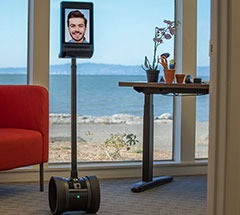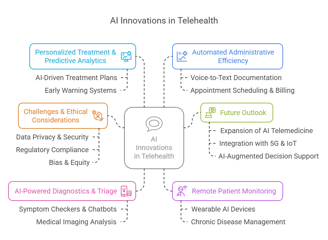Telehealth Innovations
Telehealth has emerged as a critical component of modern healthcare, and Artificial Intelligence (AI) is accelerating its evolution. By integrating AI, telehealth platforms are becoming more efficient, accurate, and accessible, bridging gaps in healthcare delivery—especially in remote and underserved regions.
Key AI Innovations in Telehealth
1. AI-Powered Diagnostics & Triage
Symptom Checkers & Chatbots: AI-driven virtual assistants (e.g., Ada Health, Buoy) analyze patient-reported symptoms and provide preliminary diagnoses, reducing unnecessary clinic visits.
Medical Imaging Analysis: AI algorithms (e.g., IBM Watson, Zebra Medical Vision) enhance radiology by detecting anomalies in X-rays, MRIs, and CT scans with high precision.
2. Remote Patient Monitoring (RPM)
Wearable AI Devices: Smart wearables (e.g., Apple Watch, Fitbit) track vital signs (heart rate, blood oxygen) and alert providers to irregularities in real time.
Chronic Disease Management: AI predicts flare-ups in conditions like diabetes (e.g., DreaMed Diabetes) and heart disease, enabling proactive interventions.
3. Personalized Treatment & Predictive Analytics
AI-Driven Treatment Plans: Machine learning analyzes patient history and genomic data to recommend personalized therapies.
Early Warning Systems: Predictive models identify high-risk patients (e.g., sepsis, readmissions) before complications arise.
4. Automated Administrative Efficiency
Voice-to-Text Documentation: AI-powered tools (e.g., Nuance DAX) transcribe clinician-patient interactions into EHRs, reducing administrative burden.
Appointment Scheduling & Billing: AI chatbots handle scheduling, insurance verification, and billing inquiries (e.g., Olive AI).
Challenges & Ethical Considerations
Data Privacy & Security: Protecting sensitive health data in AI-driven platforms remains a top concern.
Regulatory Compliance: Ensuring AI tools meet healthcare standards (e.g., HIPAA, GDPR) is critical.
Bias & Equity: AI models must be trained on diverse datasets to avoid disparities in care.
Future Outlook
Expansion of AI Telemedicine: Wider adoption in mental health (e.g., Woebot for therapy) and post-operative care.
Integration with 5G & IoT: Faster, real-time data exchange for remote surgeries and emergency response.
AI-Augmented Decision Support: Clinicians will increasingly rely on AI for evidence-based recommendations.
AI is revolutionizing telehealth by enhancing diagnostics, monitoring, and operational efficiency. While challenges like data security and bias persist, the synergy of AI and telehealth promises a future where quality healthcare is accessible to all, anytime, anywhere.







Contact Us
Reach out for telehealth inquiries and AI integration support.
Get in touch
83 Watsonbrook Dr. Brampton, L6R 0R5, ON, Canada
contact@aidoctrine.com
Shahed Tower, 10 Floor, Mirgab, Kuwait city, Kuwait
